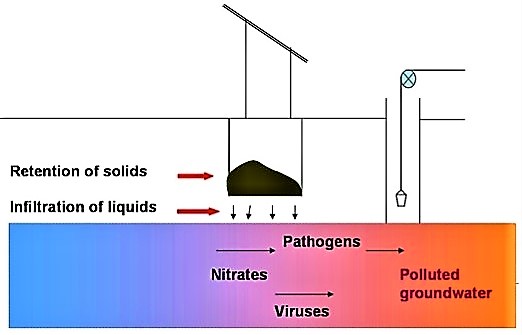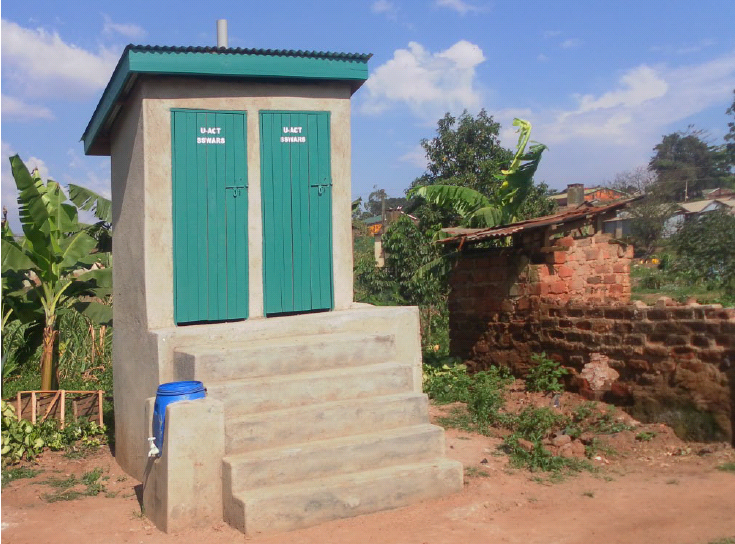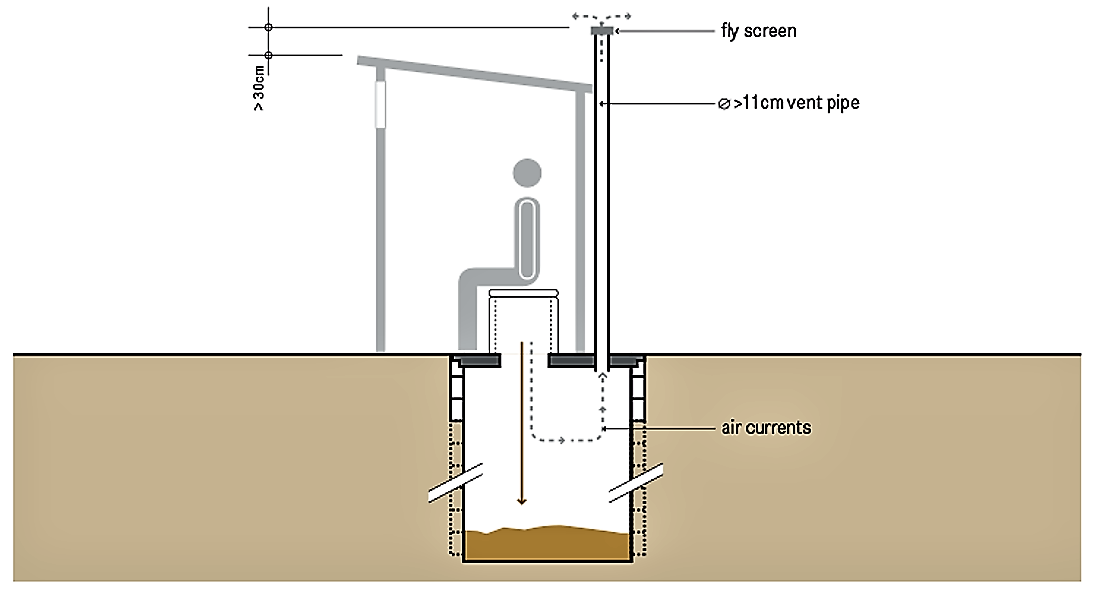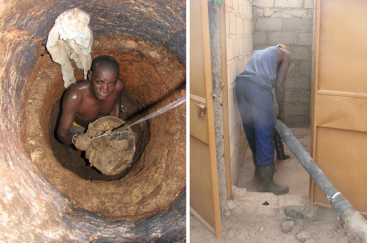Vip Toilet Design Drawings Pdf
13 May 2019
- Water & Nutrient CycleSingle Ventilated Improved Pit (VIP)
Single Ventilated Improved Pit (VIP)
Author/Compiled by
Eawag (Swiss Federal Institute of Aquatic Science and Technology)
Executive Summary
The single VIP is a ventilated improved pit. It is an improvement over the single pit because continuous airflow through the ventilation pipe vents odours and acts as a trap for flies as they escape towards the light. Yet, the single VIP remains among the simplest and cheapest toilet systems. Thus, the danger of groundwater contamination due to soil infiltration persists, especially in densely populated areas.
Advantages
Longer life than single VIP (indefinite if maintained properly)
Excavation of humus is easier than faecal sludge
Significant reduction in pathogens
Potential for use of stored faecal material as soil conditioner
Flies and odours are significantly reduced (compared to non-ventilated pits)
Can be built and repaired with locally available materials. Long service life
Does not require a constant source of water
Disadvantages
Leachate can contaminate groundwater
No specific reuse of faeces and urine
Pits are susceptible to failure/overflowing during floods; stagnant water in pits may promote insect breeding
Manual removal of humus is required
Possible contamination of groundwater
Higher capital costs than Single VIP; but reduced operating costs if self-emptied
| In | Out |
|---|---|
| Urine, Faeces, Excreta, Blackwater, Anal Cleansing Water, Dry Cleansing Material | Sludge |
[no-ecompendium]Introduction[/no-ecompendium]
Factsheet Block Body
The design of a VIP is nearly the same as a normal pit latrine – made of a superstructure, a pit cover slab and a hole for defecation – and can be used both for single and double pits. Different is only the ventilation pipe, provided with a durable fly screen on the top (SANIMAS 2005). Despite their simplicity, well-designed single VIPs can be completely smell free, and more pleasant to use than some other water-based technologies.
Flies that hatch in the pit are attracted to the light at the top of the ventilation pipe. When they fly towards the light and try to escape, they are trapped by the fly-screen and die. The toilet superstructure must be kept sufficiently dark, so that the flies leave the pit through the pipe and not through the squat hole into the toilet. The ventilation also allows odours to escape and minimizes the attraction for flies. A small gap above the door or a louvre in the door allows the air to enter. The flow of air is increased if the doorway of the superstructure faces the prevailing wind (WHO 1992).
The VIP needs no water for its function. This is a big advantage in water scarce areas in comparison with flush toilets (see flush toilets, pour flush toilets or low-flush toilets. However, compared to toilet systems such as UDDTs, composting toilets, twin-pits for pour flush, terra preta toilets, arborloo or fossa alterna), the treatment processes are limited (EAWAG/SANDEC 2008).
Design Considerations
Factsheet Block Body
The vent pipe should have an internal diameter of at least 110 mm and reach more than 300 mm above the highest point of the toilet superstructure. It can be made out of PVC, bricks, pet bottles or iron pipes. Wind passing over the top creates a suction pressure within the vent pipe and induces an air circulation. Air is drawn through the user interface into the pit, moves up inside the vent pipe and escapes into the atmosphere. Care should be taken that objects, such as trees or houses, do not interfere with the air stream. The vent works best in windy areas, but where there is little wind, its effectiveness can be improved by painting the pipe black. The heat difference between the pit (cool) and the vent (warm) creates an updraft that pulls the air and odours up and out of the pit. To test the efficacy of the ventilation, a lit cigarette can be held over the user interface; the smoke should be pulled down into the pit and up into the vent and not remain in the superstructure.
The mesh size of the fly screen must be large enough to prevent clogging with dust and allow air to circulate freely. Aluminium screens, with a hole-size of 1.2 to 1.5 mm, have proven to be the most effective. Typically, the pit is at least 3 m deep and 1 to 1.5 m in diameter, depending on the number of users. Deep pits can last up to 20 or more years. The longer a pit lasts, the lower will be the average annual economic cost and the greater the social benefits from the original input (WHO 1992).

As liquid leaches from the pit and migrates through the unsaturated soil matrix, pathogenic germs are sorbed to the soil surface. In this way, pathogens can be removed prior to contact with groundwater. The degree of removal varies with soil type, distance travelled, moisture and other environmental factors and, thus, it is difficult to estimate the distance necessary between a pit and a water source. A minimum horizontal distance of 30 m between a pit and a water source and 2 m between the bottom of the pit and the groundwater table is normally recommended to limit exposure to microbial contamination. In densely populated areas with many pit latrines it is often not possible to keep these distances between pollution sources and water abstraction points due to very limited space. In these areas, the risk of groundwater contamination remains extremely high, representing important health risks for the communities.

When it is not possible to dig a deep pit or the groundwater level is too high, a raised pit can be a viable alternative: the shallow pit can be extended by building the pit upwards with the use of concrete rings or blocks. A raised pit can also be constructed in an area where flooding is frequent in order to keep water from flowing into the pit during heavy rain. Urine diverting dry toilets (UDDTs) could also be a suitable option for regions with high groundwater table, as they are generally built above ground. In regions which tend to get flooded, "hanging UDDTs" are recommended.
A single VIP toilet can be upgraded to a double VIP. A double VIP has an extra pit so that while one is in use, the contents of the full pit are allowed to drain, mature and degrade. Once they are matured, it can be composted and can then be reused in agriculture (see also use of compost).
If a urine-diverting user interface (see urine diversion slab) is used, only faeces are collected in the pit and leaching can be minimized. The separately collected urine can be stored and reused it in agriculture. Once the faecal sludge is composted, it may also be reused in agriculture.

Health Aspects/Acceptance
Factsheet Block Body
A single VIP can be a very clean, comfortable, and well accepted sanitation option. However, some health concerns exist:
- Leachate can contaminate groundwater;
- Pits are susceptible to failure and/or overflowing during floods;
- Health risks from flies are not completely removed by ventilation.
The emptying (see invalid link and motorised) of pit latrines containing fresh excreta presents problems because of the active pathogens in the sludge. Manual removal should therefore be avoided (WHO 1992).
[no-ecompendium]Costs Considerations
Factsheet Block Body
VIPs are slightly more expensive than normal pit latrines. The construction needs some extra material (e.g. the vent pipe) and it should be noted that a ventilated design needs a roofed and darkened superstructure. Furthermore, costs for emptying the pits (see invalid link and motorised) need to be considered. It should not be a problem, however, to build de VIP with local material (WHO 1992).
Operation & Maintenance
Factsheet Block Body
To keep the single VIP free of flies and odours, regular cleaning and maintenance is required. This will also prevent the spread of pathogens (see also invalid link). Dead flies, spider webs, dust and other debris should be removed from the ventilation screen to ensure a good flow of air. When the pit is full it can either be emptied to treat and reuse the sludge (see also composting or use of compost) or the superstructure and squatting plate can be moved to a new pit. In the latter case, the old pit is covered and decommissioned, which is only advisable if plenty of land area is available. If the superstructure can be moved to a new pit, after several years, the decomposed sludge in the former pit will not cause any health problems and can be dug out without any objectionable smell. The sludge can then be used directly as a fertilizer (see also use of compost in agriculture).

[no-ecompendium]At a Glance
Factsheet Block Body
| Working Principle | A ventilated improved pit latrine (VIP) is similar to a single pit latrine with addition of a vertical vent pipe. Through the aeration in VIPs, odour and fly nuisances are reduced. Excreta, along with anal cleansing materials (water or solids) are deposited into a pit. Lining the pit prevents it from collapsing and provides support to the superstructure. |
| Capacity/Adequacy | The VIP is designed for rural and peri-urban areas. It is simple to build and can be constructed by the user itself with locally available material. |
| Performance | The treatment processes of the faecal material in the pit are limited and stagnant water may promote insect breeding. |
| Costs | Low-cost |
| Self-help Compatibility | Can be built and repaired with locally available material. It must be maintained correctly and well-kept. |
| O&M | Apart from keeping it clean, there is no daily maintenance associated with a VIP. The vent pipe should be cleaned periodically to prevent clogging. |
| Reliability | If well maintained and constructed, the excreta is at least collected in the pit and risks of infections are lower. |
| Main strength | No water required; excreta is collected; odours and fly nuisance are reduced compared with a simple pit latrine. |
| Main weakness | There is danger of groundwater contamination, because of soil infiltration (especially in densely populated areas). |
Applicability
Treatment processes in the single VIP (aerobic, anaerobic, dehydration, composting, or otherwise) are limited, and, therefore, pathogen reduction and organic degradation is not significant compared to composting or dehydration toilets. Moreover, due to infiltration, the risk of groundwater contamination is high . However, since the excreta are contained, pathogen transmission to the user is limited. This technology is a significant improvement over single pits or open defecation.
Single VIPs are appropriate for rural and peri-urban areas; in densely populated areas they are often difficult to empty and/or have insufficient space for infiltration. VIPs are especially appropriate when water is scarce and where there is a low groundwater table. Depending on the pit depth, depth to the water table, number of users and soil conditions, some pits can be used for 20 years without emptying. They should be located in an area with a good breeze to ensure effective ventilation. They are not suited for rocky or compacted soils (that are difficult to dig) or for areas that flood frequently. For areas where digging is difficult, the Arborloo could be a suitable option. As an alternative for regions with high groundwater table or frequent flooding, Urine diverting dry toilets could be considered.
Awareness Raising Material
Alternative Versions to
Vip Toilet Design Drawings Pdf
Source: https://sswm.info/factsheet/single-ventilated-improved-pit-%28vip%29
Posted by: littletonhiming62.blogspot.com

0 Response to "Vip Toilet Design Drawings Pdf"
Post a Comment